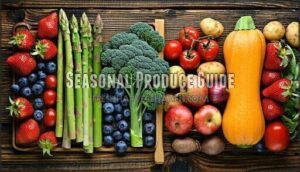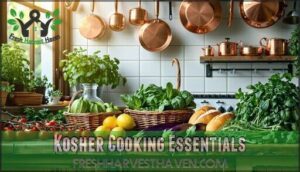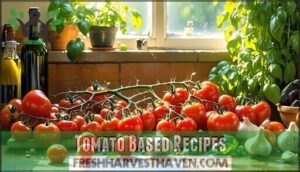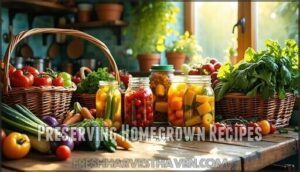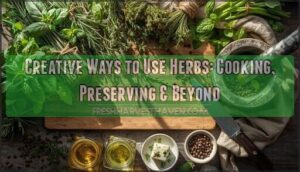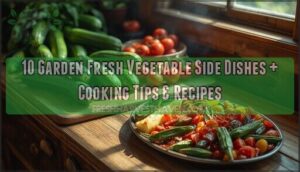This site is supported by our readers. We may earn a commission, at no cost to you, if you purchase through links.
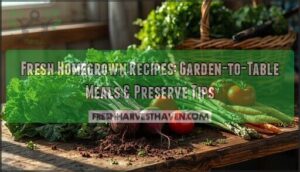
You’ll maximize taste by harvesting leafy greens like kale and spinach at ideal times, storing root vegetables properly to maintain their crisp texture, and handling delicate fruiting vegetables with care to preserve their vibrant essence.
Your seasonal harvests—from spring’s tender asparagus to winter’s hearty root vegetables—offer endless culinary possibilities that store-bought produce simply can’t match.
Whether you’re crafting a simple salad from just-picked lettuce or preparing elaborate preserves from summer’s abundance, homegrown ingredients reward you with unparalleled freshness and flavor complexity that transforms ordinary cooking into something truly special, making the most of your garden’s bounty and enjoying the culinary possibilities.
Table Of Contents
- Key Takeaways
- Fresh Homegrown Ingredients
- Seasonal Produce Guide
- Kosher Cooking Essentials
- Tomato Based Recipes
- Preserving Homegrown Recipes
- Frequently Asked Questions (FAQs)
- How do you start a garden from scratch?
- What pests commonly attack homegrown vegetables?
- When should you harvest different vegetable types?
- How much water do homegrown plants need?
- What soil preparation works best for vegetables?
- How long do homegrown vegetables stay fresh?
- What pests damage homegrown produce most often?
- When should I harvest vegetables for peak flavor?
- Can I grow herbs indoors year-round successfully?
- What soil amendments improve homegrown vegetable quality?
- Conclusion
Key Takeaways
- Harvest at peak ripeness – You’ll maximize flavor and nutrition by picking vegetables at the right time, like tomatoes when they are fully colored but firm, and leafy greens before they bolt.
- Handle produce properly from garden to kitchen – You should salt tomatoes before cooking to prevent soggy dishes, store root vegetables in cool, dark places, and wash fruits immediately after picking.
- Match your cooking to seasonal availability – You’ll get the best results by using spring’s tender asparagus for light dishes, summer’s tomatoes for fresh salsas, and fall’s root vegetables for hearty roasted meals.
- Preserve excess harvest using multiple methods – You can extend your garden’s bounty year-round through water bath canning for tomatoes, blanching before freezing vegetables, and pickling or dehydrating surplus produce.
Fresh Homegrown Ingredients
Your homegrown ingredients deserve the best treatment from garden to table.
Proper selection, storage, and handling techniques guarantee maximum flavor and nutrition from your leafy greens, root vegetables, and fruiting plants like tomatoes and peppers.
They should be handled with care to ensure proper selection.
Leafy Greens Selection
You’ll find the perfect leafy greens by focusing on variety and freshness. Growing diverse greens guarantees year-round harvests and maximum nutrition. Choose varieties that match your climate and taste preferences for guaranteed success.
Understanding the benefits of green leafy vegetables can help you make informed decisions about your garden and diet.
- Kale Selection: Pick ‘Lacinato’ for tender leaves, ‘Red Russian’ for cold tolerance
- Spinach Care: Choose bolt-resistant varieties like ‘Tyee’ for extended harvests
- Lettuce Varieties: Mix butterhead, romaine, and leaf types for texture variety
- Green Harvesting: Cut outer leaves first, leaving centers to continue growing
Root Vegetables Storage
Root vegetables thrive in cool dark places, mimicking their natural underground environment.
Nature’s underground storage system knows exactly what vegetables need—cool darkness where flavors concentrate and sweetness develops
Store potatoes and onions separately in ventilated containers—they release gases that spoil each other. Carrots and beets need humidity control; wrap them in damp paper towels before refrigerating.
For long-term storage, root cellars with proper ventilation work best. Freezing techniques require blanching first to preserve texture and nutrients, and this is crucial for maintaining the natural environment they thrive in.
Fruiting Vegetables Handling
Mastering fruiting vegetables handling transforms your garden’s bounty into culinary gold.
These vibrant crops demand attention to harvest timing and peak ripeness for maximum flavor.
When your tomatoes, peppers, and zucchini reach that perfect moment, you’ll taste the difference proper handling makes.
Fresh produce from your own soil connects you directly to nature’s rhythm.
- Check daily for ripeness signals – firm skin with vibrant color means it’s time
- Handle gently during harvest – bruised vegetables lose flavor and spoil quickly
- Wash immediately after picking – cool water removes dirt while preserving nutrients
- Store at proper temperatures – some prefer countertop ripening, others need refrigeration
Seasonal Produce Guide
Now that you’ve selected your fresh homegrown ingredients, timing your harvest and meal prep with nature’s rhythm becomes your secret weapon.
Spring Harvest brings tender asparagus and strawberries that’ll make your taste buds dance.
You can’t beat biting into a sun-warmed strawberry straight from the vine – it’s pure magic.
Summer Fruits like peaches and tomatoes hit their stride when the heat peaks, while Fall Vegetables such as pumpkins and Brussels sprouts sweeten after the first frost.
Winter Roots including parsnips and turnips actually improve in cold storage, developing concentrated flavors that transform simple roasted dishes into something special.
Your seasonal produce timing directly impacts fresh produce recipes success.
Farm to fork cooking means you’re working with nature, not against it.
Local food recipes shine when you match ingredients to their peak seasons, creating homemade meals that capture each season’s best flavors.
To maximize flavor and freshness, understanding seasonal vegetable availability is essential for garden-to-table meals.
| Season | Peak Produce | Best Uses |
|---|---|---|
| Spring | Asparagus, Strawberries, Peas | Light salads, quick sautés |
| Summer | Tomatoes, Zucchini, Berries | Fresh salsas, grilled dishes |
| Fall | Apples, Squash, Root Vegetables | Roasted meals, preserves |
| Winter | Kale, Citrus, Storage Crops | Hearty soups, braised dishes |
| Year Round | Potatoes, Onions, Herbs | Base ingredients, seasoning |
Year Round Produce like potatoes and onions anchor your pantry, letting you build satisfying meals regardless of season, with key ingredients always available to enhance your cooking.
Kosher Cooking Essentials
Creating a kosher kitchen means knowing which ingredients work together and keeping everything properly separated.
You’ll need dedicated tools for meat and dairy dishes, plus a solid understanding of seasonal produce to make the most of your homegrown harvests.
Essential Ingredients
Your kosher kitchen starts with building a solid ingredient foundation that honors dietary laws while celebrating fresh flavors. Smart shopping means knowing where your food comes from and how it’s prepared.
Key ingredients for authentic kosher cooking:
- Fresh produce recipes begin with locally sourced vegetables like carrots, zucchini, and leafy greens that you can trace from farm to fork
- Meat Options include certified kosher brisket and chicken thighs from trusted suppliers who follow proper slaughtering practices
- Dairy Alternatives encompass kosher-certified cheeses, milk, and yogurt that complement your homemade cooking tips
When you’re cooking from scratch, Herb Selection matters – fresh parsley, dill, and thyme pack more punch than dried versions. Your Vegetable Prep becomes easier when you choose firm, vibrant produce that smells right. These healthy eating habits guarantee every dish delivers maximum flavor while meeting kosher standards.
Key Kitchen Tools
A well-equipped kitchen becomes your culinary command center when you’ve got the right arsenal.
You’ll need chef knives for precision chopping, separate cutting boards to prevent cross-contamination, and mixing bowls for combining ingredients seamlessly.
Effective gardening practices, such as using proper harvesting tools, can substantially enhance the quality of your homegrown ingredients.
| Tool Category | Essential Items | Kosher Consideration |
|---|---|---|
| Cutting Tools | Chef knives, paring knives | Separate sets for meat/dairy |
| Prep Equipment | Cutting boards, mixing bowls | Color-coded or labeled clearly |
| Cooking Vessels | Sauce pans, measuring cups | Dual sets required |
These kitchen gadgets and culinary equipment transform your homegrown ingredients into restaurant-quality meals while maintaining kosher standards effortlessly.
Organizing a Kosher Kitchen
Creating effective Kosher Zones transforms your kitchen into a streamlined cooking haven.
Transform your kitchen into a kosher command center with smart design and clear organization
Proper Kitchen Design with designated areas prevents cross-contamination while supporting efficient Meal Planning for kosher recipes following kosher dietary laws.
- Separate prep stations: Designate distinct countertops for meat, dairy, and pareve ingredients with clear Food Labeling systems
- Color-coded Utensil Management: Use red for meat, blue for dairy, preventing mix-ups during kosher cooking
- Dual storage solutions: Install separate cabinets and drawers for each category, ensuring kosher certification compliance
- Strategic workflow planning: Position kosher kitchen zones to minimize cross-traffic between meat and dairy preparation areas
A well-designed kosher kitchen should incorporate kosher design principles to maintain separation and clarity.
Tomato Based Recipes
When your garden overflows with sun-warmed tomatoes, you’ll discover these varieties transform ordinary meals into extraordinary experiences.
Each recipe captures peak-season flavor, whether you’re working with sweet cherry tomatoes or robust heirlooms that practically burst with summer sunshine.
Tomato Galette Preparation
Mastering the art of tomato galette preparation transforms your summer produce into a rustic masterpiece.
Salt your fresh tomatoes for 30 minutes before assembly—this essential step prevents soggy pastry crust disasters that’ll make you question your farm-to-table dreams.
Utilizing fresh tomato recipes can elevate your garden-to-table meals with unique flavor profiles and techniques.
| Step | Technique | Timing |
|---|---|---|
| Prep tomatoes | Salt slices, drain on towels | 30 minutes |
| Make pastry crust | Chill dough thoroughly | 60 minutes |
| Create galette filling | Layer cheese, arrange tomatoes | 10 minutes |
| Apply baking tips | Egg wash edges, 400°F oven | 35 minutes |
| Flavor enhancement | Fresh herbs after baking | 5 minutes |
Your homemade recipes deserve attention to detail—wet tomatoes equal disappointment.
Heirloom Tomato Salad Creation
Your heirloom tomatoes deserve a stage that lets their natural beauty shine.
Give your heirloom treasures the spotlight they’ve earned through seasons of patient care.
Choose vibrant Tomato Varieties with different colors and sizes, then slice them generously.
A simple Salad Dressing of olive oil and vinegar won’t compete with their flavor.
Scatter Fresh Herbs like basil between layers, creating perfect Vegetable Pairing.
Let those gorgeous Flavor Profiles speak for themselves—no fussy additions needed.
Four Tomato Salsa Recipe
Blending four tomato varieties transforms your salsa from ordinary to extraordinary.
You’ll combine cherry tomatoes for sweetness, beefsteaks for body, and paste tomatoes for thickness.
Add jalapeños, onions, and cilantro to create layers of flavor.
This homemade salsa showcases fresh produce while supporting the farm-to-table movement with garden-fresh ingredients and proven cooking techniques.
Preserving Homegrown Recipes
When your garden overflows with fresh produce, proper preservation guarantees you’ll enjoy those homegrown flavors year-round.
You’ll discover that mastering food storage, canning, freezing, pickling, and dehydrating transforms your seasonal harvest into a pantry full of delicious ingredients ready for any meal, with complete concepts like these allowing for better meal planning.
Food Storage Tips
Proper food storage keeps your harvest fresh longer and prevents waste.
Store leafy greens in perforated bags with humidity control to maintain crispness.
Root vegetables need cool, dry spaces away from light.
Use airtight storage containers for maximum shelf life and food safety.
Label everything with dates.
Different refrigeration methods work best for different produce types.
Canning and Freezing Methods
Lock in your harvest’s peak flavor through proven food preservation techniques.
Water bath canning works perfectly for high-acid tomatoes and fruits, while pressure canning handles low-acid vegetables safely.
For freezing methods, blanch vegetables first to preserve color and nutrients.
Both canning tips and freezing meals extend your garden’s bounty year-round with proper technique.
Understanding proper canning recipes is essential for successful preservation.
Pickling and Dehydrating Techniques
Beyond canning, you’ll discover that pickling and dehydrating reveal your garden’s full potential.
These preserving techniques transform excess vegetables into shelf-stable treasures. Homemade pickles require proper acidifying agents, while dehydrating fruits needs consistent heat and airflow.
Master these food preservation methods, and you’ll enjoy your harvest year-round with concentrated flavors that store beautifully.
To achieve the best results, using the right pickling jars is essential for successful preservation with proper acidifying agents.
Frequently Asked Questions (FAQs)
How do you start a garden from scratch?
Rome wasn’t built in a day, but your garden can start strong! Choose a sunny spot, test your soil, and begin with easy crops like lettuce or radishes.
What pests commonly attack homegrown vegetables?
Common culprits include aphids, whiteflies, and mites that suck plant sap, plus Colorado potato beetles, striped cucumber beetles, flea beetles, Mexican bean beetles, and harlequin cabbage bugs.
You’ll also battle hornworms and loopers chomping leaves.
Effective pest control methods can help minimize the damage caused by these insects.
When should you harvest different vegetable types?
You’d think vegetables ripen on their own schedule, but you’re actually the conductor of this garden orchestra.
Harvest leafy greens when tender, root vegetables after soil cools, and fruiting crops at peak color.
How much water do homegrown plants need?
Most vegetables need 1-2 inches of water weekly, including rainfall.
You’ll water deeply but less frequently, encouraging strong root development.
Check soil moisture by sticking your finger two inches down—if it’s dry, it’s watering time.
What soil preparation works best for vegetables?
You’ll want loose, well-draining soil enriched with compost or aged manure.
Test your pH—most veggies thrive between 0-
Mix organic matter deep, break up compacted areas, and let it settle before planting.
How long do homegrown vegetables stay fresh?
Picture your freshly picked vegetables slowly losing their vibrant crispness day by day.
Most homegrown veggies stay fresh 3-14 days when stored properly—leafy greens wilt fastest, while root vegetables like carrots and potatoes can last weeks in cool, dark storage, which helps preserve their freshness and crispness.
What pests damage homegrown produce most often?
Aphids, spider mites, and caterpillars wreak the most havoc on your homegrown vegetables.
These tiny troublemakers multiply fast, sucking plant juices or munching leaves until your beautiful crops look like they’ve been through battle.
They are tiny troublemakers that can cause significant damage to your crops.
When should I harvest vegetables for peak flavor?
Harvest vegetables in the early morning when sugar levels peak and temperatures are cool.
Pick tomatoes when they’re fully colored but still firm, leafy greens before they bolt, and root vegetables after light frost sweetens them naturally, which often happens after a light frost.
Can I grow herbs indoors year-round successfully?
Basil, cilantro, and thyme thrive indoors year-round with proper lighting and care.
You’ll need bright windows or grow lights, well-draining soil, and consistent watering.
Most herbs flourish in containers, giving you fresh flavors regardless of weather outside, with proper care.
What soil amendments improve homegrown vegetable quality?
You’ll transform your garden’s output by adding compost for nutrients, organic matter for soil structure, and balanced fertilizers for steady growth.
These amendments create thriving conditions that boost flavor and nutrition naturally, leading to a more balanced garden ecosystem.
Conclusion
Research shows that home gardeners harvest vegetables at 30% higher nutrient density compared to store-bought produce.
Growing your own ingredients transforms everyday cooking into something extraordinary. You’ll discover that fresh homegrown recipes deliver flavors that can’t be replicated with commercial produce.
Whether you’re preserving summer’s abundance or crafting tonight’s dinner, your garden provides ingredients with unmatched freshness and complexity.
Start small, experiment boldly, and let your harvest guide your culinary adventures into delicious new territory.
- https://hospitalityinsights.ehl.edu/home-cooking-trends-techniques-benefits
- https://nutrimill.com/blogs/life-in-healthy-balance/why-homemade-matters-unlocking-the-hidden-benefits-of-cooking-from-scratch
- https://www.gardentech.com/blog/gardening-and-healthy-living/garden-to-table-goodness-and-nutrition
- https://www.farmaid.org/festival/homegrownconcessions/homegrown-chili-farm-aid-super-bowl-recipe/
- https://www.buzzfeed.com/hannahloewentheil/best-homemade-dishes

